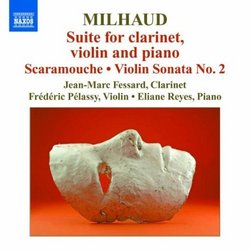| All Artists: Milhaud, Reyes, Pelassy, Fessard Title: Suite for Clarinet / Violin & Piano / Scaramouche Members Wishing: 0 Total Copies: 0 Label: Naxos Original Release Date: 1/1/2010 Re-Release Date: 9/28/2010 Genre: Classical Style: Number of Discs: 1 SwapaCD Credits: 1 UPCs: 747313227877, 747313227877 |
Search - Milhaud, Reyes, Pelassy :: Suite for Clarinet / Violin & Piano / Scaramouche
 | Milhaud, Reyes, Pelassy Suite for Clarinet / Violin & Piano / Scaramouche Genre: Classical
|
Larger Image |
CD Details |
CD ReviewsMilhaud chamber music for the theater in vivid performances! Daniel R. Coombs | Mesa, AZ United States | 10/04/2010 (5 out of 5 stars) "This new Milhaud chamber music collection featuring clarinet, violin and piano stands quite well as a very good new recording of some of his best known works for those combinations. However, four of the works, the "Suite" op. 157, "Scaramouche", "Le Printemps" and the Fantaisie after "Le Boeuf sur le toit" are all works originally conceived to be incidental music for plays, brought together here for one of the few recordings to ever group these important works for that reason. The "Suite" has, as its derivation,the Jean Anouilh play, "Le voyager sans bagages" from 1936. Patterned instrumentally and conceptually after Stravinsky's "L'histoire du soldat", this is a brief, engaging work in a light, engaging mood. "Scaramouche" is, in some ways, an even more "upbeat" and tongue in cheek work, aligning in mood to the Voltaire farce from which Charles Vildrac derived his play, "Le Medecin volant" Milhaud's music even expends some of the French fascination with all things Latin in the final "Brazileira". The other two theater pieces in this set, "Le printemps" written in 1914 for the Paul Claudel play, "Protee", and the "Cinematic Fantasy (Fantaisie)" are equally frothy, entertaining little works. The fantasy after "The boeuf sur la toit" (The Ox on the Roof) is particularly interesting. The Cocteau play was under consideration for adaptation into a film featuring the great Charlie Chaplin (who, to this day, the French simply idolize) but it never came about. Milhaud's music in this case, also, is a bit Brazil-inspired and fun, spiky and somewhat humorous. This work did later get realized as a ballet. The 1917 "Violin Sonata #2" has as its connection to this collection the fact that it was written during the composer's stay in Rio de Janeiro and is a welcome addition to the - perhaps lesser known - sonata repertoire. The "Sonatina" for clarinet and piano was written for the great French clarinetist, Louis Cahuzec and is a bit darker and more overtly polytonal than the other works. The outer movements, both labeled "tres rude" ("rough" in English, not literally, 'rude') are quirky, difficult and attention getting. Well played by clarinetist Jean-Marc Fessard, my one surprise was the tempi. Fessard plays the piece slower, throughout, than I learned it ('back in the day') and certainly slower than the Stanley Drucker-Leonid Hambro recording from the mid 1960s. However, the more laid back speed allows some of the odd harmonies to shine through and gives the work a more "mysterious" feel. This music, as in all Milhaud, is ever so "French". All members of "Le Six" were striving for a new, unique sound that expressed the alternately care free and pessimistic Parisian 'raison d'etre'. The performances by Fessard, violinist Frederic Pelassy and pianist Eliane Reyes are of the highest quality. I recommend this to anyone who enjoys Milhaud, early twentieth century French music in general or to fans of chamber music that is not heard enough. Allez entendent ceci pour vous-même !"
|

 Track Listings (16) - Disc #1
Track Listings (16) - Disc #1